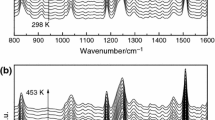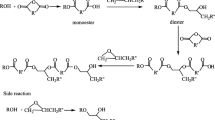Abstract
The methodology and results of cyclocarbonylation kinetic study for chlorinated epichlorohydrine oligomers with sodium bicarbonate are presented. Calvet calorimetry is applied as the main kinetic research technique. Correlation between heat production and epichlorohydrine groups conversion has been established. A mathematical model of the cyclocarbonylation reaction in a two-phase “solid–liquid” system has been developed. The proposed model takes into account mass transfer phenomena between the two phases as well as chemical reactions in the liquid reaction phase. The mathematical model kinetic parameters were determined in the result of solving an inverse kinetic task with applying heat production experimental data together with product concentrations data. The model developed in course of the work was used to determine the optimal conditions for running cyclocarbonylation process.






Similar content being viewed by others
References
Webster DC. Cyclic carbonate functional polymers and their applications. Prog Org Coat. 2003;47:77–86.
Rokicki G. Progr Polym Sci (Oxf). 2000;25:259–342.
North M. Synthesis of cyclic carbonates from epoxides and carbon dioxide using bimetallic aluminium(salen) complexes. ARKIVOC. 2012;i:610–28.
Webster DC, Crain AL. In: Patil AO, Schulz DN, Novak BM, editors. Functional polymers: modern synthetic methods and novel structures. Am Chem Soc. 1998;704:303–20.
Weissermel K, Arpe H-J. Industrial organic chemistry. 3rd ed. New York: VCH; 1997.
Patent No. DE 3723782 C2, Germany.
Shapiro AL, Lyubovsky IS. Kinetics and mechanism of reactions of α-oxides with carbon dioxide. Alkylencarbonates. Collection of Scientific Papers: L.: VNIINeftekhim; 1975. p 6–12.
Reutov OA, Kurtz AL, Butin KP. Organic chemistry. In: 4 Volumes. vol. 2, Chap. 9–11, M.: BINOM. Laboratory of Knowledge, 2004. pic. ISBN 5-94774-113-3 (vol. 2).
Streitwieser A, Heathcock CH, Kosower E. Introduction to organic chemistry. 4th ed. New York: Macmillan; 1992. p. 1256.
Murias P, Byczyński Ł, Maciejewski H, Galina H. A quantitative approach to dynamic and isothermal curing of an epoxy resin modified with oligomeric siloxanes. J Therm Anal Calorim. 2015;122(1):215–26.
Wang H, Zhang Y, Zhu L, Du L, Zhang B, Zhang Y. Curing behaviors and kinetics of epoxy resins with a series of biphenyl curing agents having different methylene units. Thermochim Acta. 2011;521:18–25.
Ghaffari M, Ehsani M, Khonakdar HA, Assche GV, Terryn H. Evaluation of curing kinetic parameters of an epoxy/polyaminoamide/nano-glass flake system by non-isothermal differential scanning calorimetry. Thermochim Acta. 2012;533:10–5.
Ooi SK, Cook WD, Simon GP, Such CH. DSC studies of the curing mechanisms and kinetics of DGEBA using imidazole curing agents. Polymer. 2000;41:3639–49.
Dai Z, Li Y, Yang S, Zhao N, Zhang X, Xu J. Kinetics and thermal properties of epoxy resins based on bisphenol fluorene structure. Eur Polym J. 2009;45:1941–8.
Vyazovkin S, Burnham AK, Criado JM, Pérez-Maqueda LA, Popescu C, Sbirrazzuoli N. ICTAC Kinetics Committee recommendations for performing kinetic computations on thermal analysis data. Thermochim Acta. 2011;520:1–19.
Ozawa T. Kinetic analysis of derivative curves in thermal analysis. J Therm Anal. 1970;2:301–24.
Koga N. Ozawa’s kinetics method for analyzing thermoanalytical curves. History and fundamentals. J Therm Anal Calorim. 2013;113:1527–41.
Kissinger HE. Reaction kinetics in differential thermal analysis. Anal Chem. 1957;29:1702–6.
Sharikov YV, Sharikov FY, Titov OV. Optimization of process conditions in a tubular rotary kiln with applying TG/DSC technique and mathematical modeling. J Therm Anal Calorim. 2015;122:1029–40.
Sharikov YV, Benin AI, Kossoy AA. Automated system of thermal explosion study of chemical and technological processes. VChO by D.I. Mendeleev, No. 4; 1990, p. 428.
Benin AI, Kossoy AA, Sharikov FY. Automated system of kinetic research in thermal analysis. II. Organization of kinetic experiments in ASKR. J Therm Anal. 1992;38:1167–80.
Shapiro AL, Ryzhenkov AM. Mechanism of the reaction of ethylene oxide with carbon dioxide in aqueous solution. Alkylenecarbonates. Collection of Scientific Papers: L.: VNIINeftekhim; 1975. p. 25–31.
Shapiro AL, Lyubovsky IS, Levin SZ, Skop VI, Vorobiev BL. Catalytic reactions of alkylene carbonates. Alkylencarbonates. Collection of Scientific Papers: L.: VNIINeftekhim; 1975. p. 12–7.
Vorob’ev BL, Zhesko TE, Shapiro AL. Interaction of halogenated alkilene-hydrins with bicarbonate ion in aqueous solutions. Alkylencarbonates. Collection of Scientific Papers: L.: VNIINeftekhim; 1975. p. 50–6.
Ryzhenkov AM, Shapiro AL, Zakoshanskaya LA, Taradina EI. Hydrolysis of ethylene and propylene in the presence of carbonate salts at an atmospheric pressure. Alkylencarbonates. Collection of Scientific Papers: L.: VNIINeftekhim; 1975. p. 67–76.
Ryzhenkov AM, Shapiro AL. Neutral and alkaline hydrolysis of ethylene carbonate with a stoichiometric amount of water under the pressure of carbon dioxide. Alkylencarbonates. Collection of Scientific Papers: L.: VNIINeftekhim;1975. P. 76–87.
Sharikov YV, Beloglazov IN. Modeling of systems. Part 1. SPb: Saint-Petersburg State Mining University; 2011. p. 108.
Sharikov YV, Beloglazov IN. Modeling of systems. Part 2. SPb: Saint-Petersburg Mining University; 2012. p. 118p.
Ryzhenkov AM, Shapiro AL, Moschenko VS. Hydrolysis of ethylene under the pressure of carbon dioxide in the presence of halide salts. Alkylencarbonates. Collection of Scientific Papers: L.: VNIINeftekhim; 1975. p. 87–94.
Graham Solomons TW. Fundamentals of organic chemistry. New York: Wiley; 1982. p. 827.
Carey FA, Sandberg RJ. Advanced organic chemistry. Part “A” and “B”. New York: Plenum Press; 1990.
Acknowledgements
Calorimetric measurements and data processing were performed in St. Petersburg Mining University with the equipment and software obtained due to the Development Program “National Research University” (2011–2013) in course of the ministry program “Support of Fundamental Research Works” (2014–2016). The authors are grateful to their colleagues A. Velts and V. Lunev, who provided the chemical background and reagents and performed the necessary chemical analyses to fulfill this work.
Author information
Authors and Affiliations
Corresponding author
Rights and permissions
About this article
Cite this article
Sharikov, F.Y., Sharikov, Y.V. The study and modeling of cyclocarbonylation reactions for chlorinated epoxy resins with applying Calvet calorimetry. J Therm Anal Calorim 126, 743–754 (2016). https://doi.org/10.1007/s10973-016-5580-x
Received:
Accepted:
Published:
Issue Date:
DOI: https://doi.org/10.1007/s10973-016-5580-x




